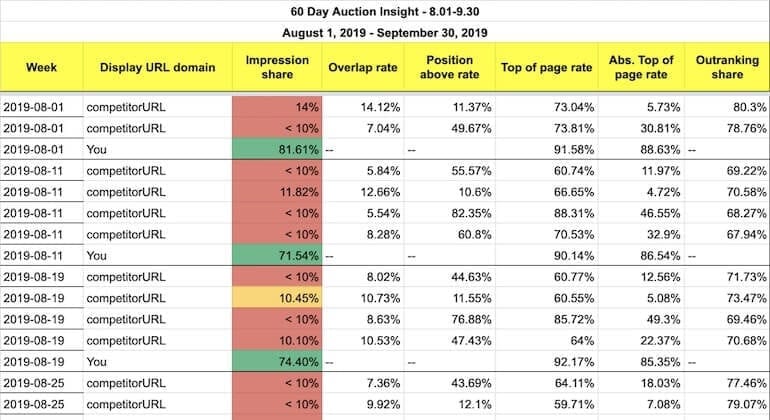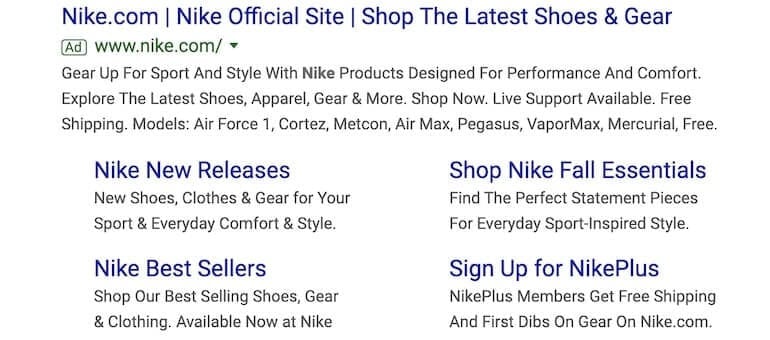Ongoing PPC search campaign analyses are crucial to improve performance and cut wasted spend. Extensive analysis should always be performed upon acquisition of new accounts, but they should also be conducted as part of account maintenance. There is always room to improve as the paid search landscape is always evolving. In this post, we’ll discuss 3 of the top analyses to run with the associated action items.
Auction Insights and Competitor Analysis
Use Google Auction Insights, which looks at:
- Impression share
- Overlap rate
- Position above rate
- Top of page rate
- Outranking share
Compile auction insights into a spreadsheet. Run your auction insight report week by week for a defined period of time (for example, 60 days) and compile each week into your report. Segmenting by week ensures you evaluate trends at a granular level over your defined period of time.

Next, search for questions and use a competitive research tool to find answers. For example, high impression share on your auction insights report may seem like a win, but you could be missing out by not participating in the space your competitors are in. If you come across campaigns where you have a fair amount of overlap with businesses you don’t consider to be competitors, review your search terms to see if you are bidding too broadly. If competitors have a lot of overlap with you, start a keyword research project to find where the overlap seems to be. Use the competitive research tool to find what your competitors are bidding on that you aren’t and explore what ads they are using. You may find competitors with a curiously low impression share so you’ll want to research these keywords. You may also identify new competitors and learn more about their brand and compare your landing pages. Lastly, evaluate if you are spending more than you need to. It is possible you can maintain your market share while shifting your budget to other initiatives.
Quality Score Analysis
Quality Score is an estimate of how relevant your ads, keywords, and landing pages are to the person who sees your ad. Higher Quality Scores typically lead to lower costs and better ad positions. It’s common to overlook Quality Score as it tends to not be a metric that clients review as much as conversions, cost, etc. While it can be a poor conversion predictor, it is still a valuable metric to track and optimize because it impacts your performance. A high Quality Score allows you to rank higher and get more impressions. As you work to improve your Quality Score, keep in mind it reflects the quality of each ad, so you always need to analyze it with other metrics to understand the entire picture. This ensures you understand your marketing efforts overall and what is leading to success. Utilize a Quality Score Template, such as the one provided by Supermetrics. Look for opportunities to increase landing page experience and message match. Ensure your landing page content is relevant and useful to the searcher and ensure that your targeted keywords are carried over to the content on the landing page. Message match is a measure of how closely your landing page copy matches the copy of the ad or link that brought someone there. A strong message match increases conversions because it aligns the message.
Ad Copy and Extensions
It’s easy to be caught up in all of the technical aspects of PPC and overlook the need for high quality and relevant copy. Analyze your current ad copy and ensure it aligns with the following. Utilize compelling, genuine ad copy and start by ensuring the top keywords are in the ad copy. Try to incorporate these into the headline, body, and display URL if possible because users tend to engage with ads that appear most relevant to their search.
If your keywords are not relevant to the ad copy, evaluate whether the keywords should be moved to a different or new ad group or be removed all together. Focus your message on user benefits while avoiding generic language because potential clients and customers will respond to ads that speak to their needs. Specific calls to action increase engagement. Implement the ad extensions that make sense for your business, with a minimum goal of three. Ads with multiple extensions tend to perform better than ads with only one extension.

Extensions are especially useful for users as they add helpful, relevant information and help your message get noticed. After you analyze your ad copy, make sure you test and optimize different creatives so you can gain insight into your users’ preferences and improve your performance.
Recap
In addition to these 3 analyses, you can complete an entire account audit. Staying abreast of the details of your account will drive projects and initiatives, ensuring your campaigns remain fresh, relevant and performing. Deep knowledge creates purposeful action items that will drive results.




